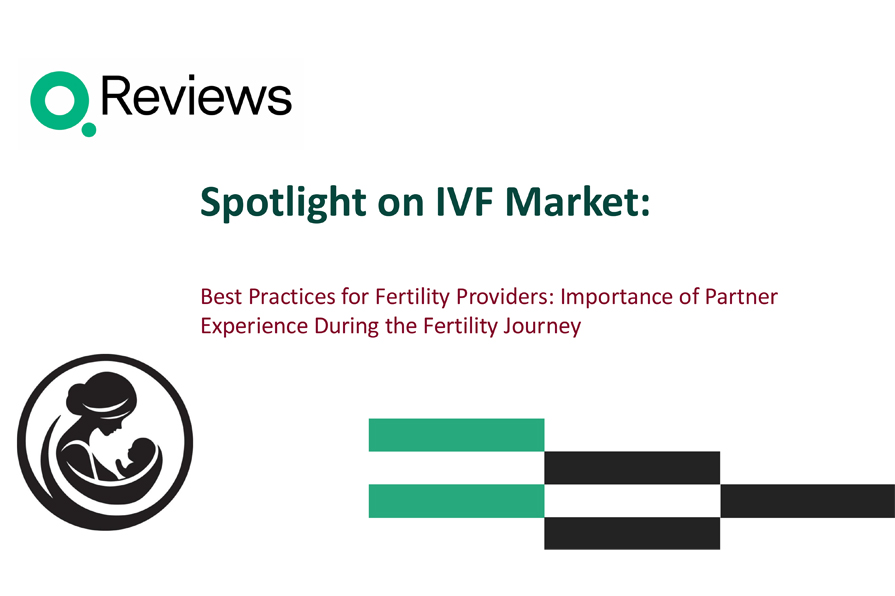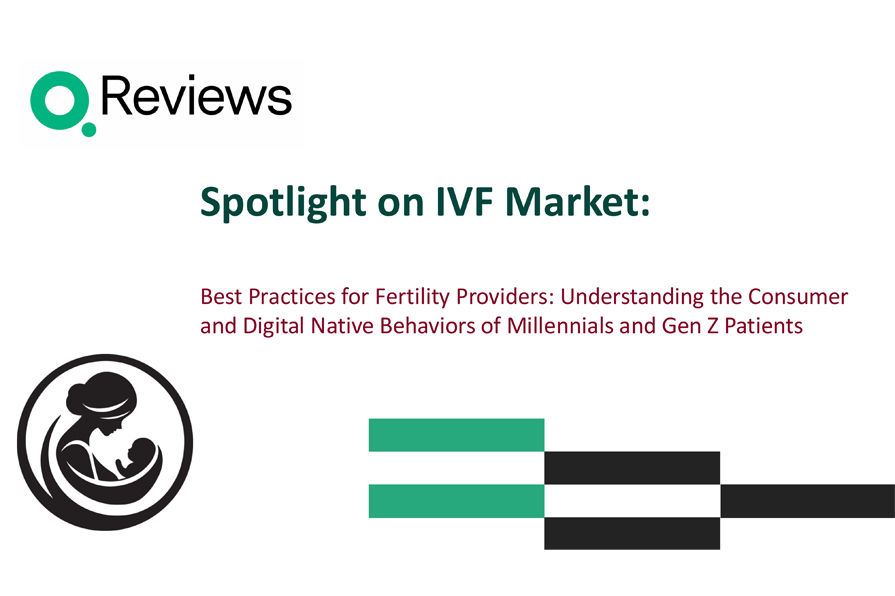
IVF in 2024: Trends, Challenges, & Opportunities

IVF Trends: Dr. Alan Copperman, Managing Director & CEO of RMA of New York. says IVF’s shift from luxury to essential healthcare practice, highlighting its growing importance.
Copperman, who also serves as Division Director of Reproductive Endocrinology and Infertility and Clinical Professor of Obstetrics, Gynecology, and Reproductive Science at the Icahn School of Medicine at Mount Sinai, sat down with Quality Reviews CEO Edward Shin to discuss the progress that IVF has made in recent years — and what’s ahead in 2024 — in a recent webinar.
Read on for some of the highlights from their conversation, including why IVF is becoming more accessible than ever, how clinics are ensuring better outcomes, what patients want from their providers, and more.
Unprecedented Access
The IVF market in 2023 is larger than it ever has been and shows no signs of slowing down. Copperman credits this to a couple of main reasons. For one, there’s simply greater awareness. Discussions around fertility challenges and IVF are now commonplace in both the media and among peer groups.
“There’s more coverage, more awareness, more normalization. We have pockets of friends coming in and cycling together,” Copperman said. “This is mainstream now. It’s a sea change.”
Just as importantly, more insurance plans are covering IVF. When individuals no longer have to bear the cost of IVF out of pocket, they embrace it with enthusiasm. Employers have taken note of this, and are now opting for healthcare plans that cover IVF as a way to attract and retain employees.
Interestingly, this benefit isn’t just limited to tech companies and law firms. Copperman says that unions have begun securing plans that cover IVF for their members, leading to an uptick in IVF use among teachers, policemen, firefighters, and court workers.
“We’re seeing communities that have been underserved in the past — the LGBTQ community, communities of color — suddenly able to access care at an exciting pace,” Copperman said.
This isn’t just happening in New York and California, either. IVF is exploding throughout the country, from the Midwest to Texas, Florida, and beyond.
Better Clinical Outcomes
In addition to better access, Copperman reports better outcomes throughout the industry. This is partially due to an increased focus on fertility preservation, which Copperman calls “a game-changer.”
A decade ago, Copperman shared, the average age of a patient freezing their eggs was 38. Today, that age has decreased to 35, resulting in more healthy eggs that are more likely to result in successful pregnancies.
Advances in big data and artificial intelligence have also helped ensure better outcomes. Copperman says that clinics can now leverage anonymized data from large cohorts of past patients, and apply modeling to help inform the best course of treatment for individuals. His clinic has even developed decision support tools that use AI to help patients answer questions like how many eggs they need to preserve at age 35 to reach their goal of having two children by age 45.
Data sets like these can even help providers see why some clinics have better success rates than others. One clinic with a success rate of 30% with 35-year-olds, for example, might discover that the difference between their practice and one with a success rate of 60% among 35-year-olds lies within the specific stimulation technique they use or whether they use a pressurized HEPA with a charcoal UV filter in their laboratory.
Of course, surgical and procedural advances are contributing to better outcomes as well. Imaging recognition has already improved, allowing fertility patients to select the eggs, sperm, and embryos with the greatest chance of success — and will only continue to advance in the years to come.
Increased Consolidation
One of the greatest changes in the IVF industry over the years has been where exactly the care is delivered. Initially, Copperman shared, IVF was performed almost exclusively in academic centers. Copperman’s own practice started out with an operating room and laboratory in a research hospital but found that the needs of an IVF clinic versus a general hospital often clashed.
Hospitals’ standard practice of bleaching the floors, for example, poses a hazard to frozen gametes, while IVF clinics require 24/7 use of the HVAC system, even when hospitals don’t. As a result, Copperman’s practice decided to open its own dedicated space.
The industry as a whole generally followed suit — “the days when an academic medical center contained their IVF center inside the four walls of an ivory tower are largely gone,” Copperman explained. And as IVF has grown in popularity, more and more independent clinics have opened up. This presents its own challenges, though.
Copperman’s practice maintains an academic affiliation with their parent health system, allowing them to share research, publish papers, teach residents, and closely collaborate as a whole. Most independent IVF clinics, however, don’t have these resources, which can hold them back.
“The cost of doing business goes up every single year, and reimbursements go down. We’re dealing with inflation. We’re dealing with supply chain issues, especially since COVID. And what that means is that we need to partner,” Copperman said.
He believes that “the business of IVF will be more consolidated” moving forward, as smaller, independent clinics are increasingly bought out by or partner with larger institutions.
“It’s harder and harder for small programs to have the resources, the manpower, the brand new technology,” Copperman explained. “We need sophisticated business models that allow us to focus on medicine and taking great care of patients while still having the resources to invest in research and development and hire and retain the best employees.”
Greater Focus on Patient Experience
Amidst expanding access, advancing technology, and industry changes, Copperman emphasized that IVF providers must not lose focus on the heart of their practice: their patients.
“This is not about delivering care, but partnering with patients to give them the care that they need and want,” Copperman said.
His practice, for example, has been using digital engagement solutions to better understand their patients’ wishes, concerns, and challenges — then using the insights they glean to update the way they operate. To better serve their LGBTQIA+ community, for example, they’ve taken gendered language out of their consent forms and patient portal, and have updated intake forms to include a pronoun field so that people of all genders feel “welcome, heard, and seen” from the start.
They’ve also been expanding their telemedicine practice. Even if virtual appointments are no longer a necessity the way they were at the height of the COVID-19 pandemic, they offer a convenient alternative for busy patients.
“Rather than having someone take another day off of work to come in after a freezing cycle, we can have a five-minute Zoom conversation where we discuss how they’re feeling, whether they’re satisfied with the outcome, and what it means for their future fertility,” Copperman said. “It’s a digital world. Let’s embrace it.”
And in a post-CARES Act age, Copperman’s practice is working to bring more transparency than ever to patients. Their portal now offers patients same-day information on their hormone levels, test results, instructions, and more. They’ve even been sharing instructional videos, and doubling down on answering FAQs about their staff, clinical outcomes, and operations.
“Infertility provokes anxiety due to the loss of control, but we can help patients gain back some of that control with information,” Copperman shared.
A Historic Inflection Point
Even with so much progress made in recent years, Copperman is certain that the advancements in IVF are only just beginning.
“Over the next five years, we’re going to see a lot of this process being automated. Robotics and AI, microfluidics, robotics, digital chain of custody… These aren’t just buzzwords. This is the direction that our field is heading,” Copperman said.
Advancements in whole-genome sequencing and molecular gene editing via CRISPR, meanwhile, are likely to help couples with inheritable genetic diseases conceive and deliver healthy babies. Copperman even believes that the creation of artificial gametes isn’t far away — in five to ten years, he said, we may be able to take a cell from a patient’s cheek and turn it into an artificial sperm cell or egg cell.
“This is just about the most exciting field of medicine, and this is a time when we should be celebrating our victories,” Copperman said.
And if those technological advancements are paired with excellent patient care, the future for IVF is indeed bright.








